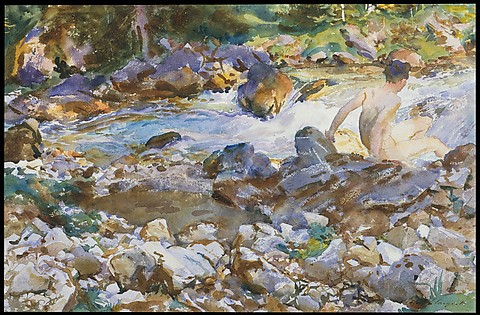

"Mountain Stream" (1912-14) by John Singer Sargent, watercolor and graphite on off-white wove paper. The Metropolitan Museum of Art.
Many of the books about watercolor technique can be found in the following range:
 American Watercolors
by
A brief history of watercolor -- First views of the new land -- A grass-roots tradition -- Frontiers and waterways -- Academics and originals -- Winslow Homer -- Americans abroad -- John Singer Sargent -- John Marin -- New directions -- Charles Burchfield -- Edward Hopper and the Realists -- The postwar avant-garde -- The postwar Realists.
American Watercolors
by
A brief history of watercolor -- First views of the new land -- A grass-roots tradition -- Frontiers and waterways -- Academics and originals -- Winslow Homer -- Americans abroad -- John Singer Sargent -- John Marin -- New directions -- Charles Burchfield -- Edward Hopper and the Realists -- The postwar avant-garde -- The postwar Realists.
 Painting the Marine Scene in Watercolor
by
Painting the Marine Scene in Watercolor
by
 Painting trees & landscapes in watercolor.
by
Materials -- Composition -- Value arrangement -- Fog and rain -- Road puddles -- On painting roads -- Useful strokes for painting trees -- Painting trunks and foliage -- The forest -- Ten varieties of trees -- The willows -- Evergreens -- The maple tree -- The birches -- The sycamore -- The palms -- The elm tree -- The oaks -- Lombardy poplar and aspen -- Monterey cypress -- Practice subjects.
Painting trees & landscapes in watercolor.
by
Materials -- Composition -- Value arrangement -- Fog and rain -- Road puddles -- On painting roads -- Useful strokes for painting trees -- Painting trunks and foliage -- The forest -- Ten varieties of trees -- The willows -- Evergreens -- The maple tree -- The birches -- The sycamore -- The palms -- The elm tree -- The oaks -- Lombardy poplar and aspen -- Monterey cypress -- Practice subjects.
 Landscapes in Watercolor
by
Landscapes in Watercolor
by
 Watercolor portrait painting
by
Artist Jan Kunz explains and demonstrates the five steps to vibrant, lifelike watercolor portraits. Jan shows what to look for in a model and how to boldly render hair and features for a fresh dynamic result. She discusses proper value relationships, color temperature, what to include in your drawing, how to divide the face into manageable parts, where to look for cool and warm areas of the face, and provides color mixing and color call outs.
Watercolor portrait painting
by
Artist Jan Kunz explains and demonstrates the five steps to vibrant, lifelike watercolor portraits. Jan shows what to look for in a model and how to boldly render hair and features for a fresh dynamic result. She discusses proper value relationships, color temperature, what to include in your drawing, how to divide the face into manageable parts, where to look for cool and warm areas of the face, and provides color mixing and color call outs.